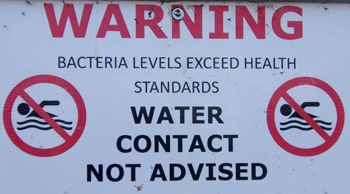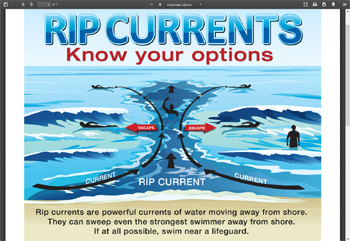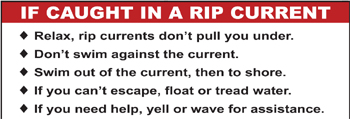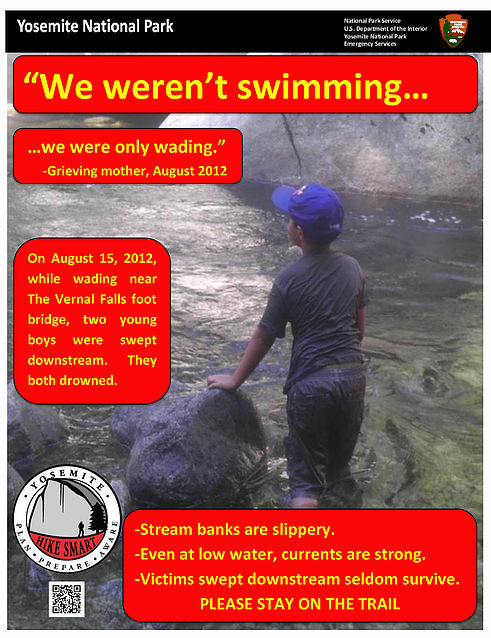Material, from the curriculum for swim classes at De Anza College:
This list is adapted in part from U.S.A. and Canadian Red Cross material.
· Be knowledgeable of the water environment you are in and its potential hazards, such as deep and shallow areas, currents, depth changes, obstructions and where the entry and exit points are located.
The more informed you are, the more aware you will be of hazards and safe practices.
There are places where the water is not safe (clean enough) to enter, watch for signs.
This was at a southern California beach.
If people were not looking for signs when they got to the beach, they might have missed the warning.
WARNING
BEACH WATER MAY CONTAIN SEWAGE
AND MAY CAUSE ILLNESS
·Pay attention to local weather conditions and forecasts. Stop swimming at the first indication of bad weather, especially at the first sound of thunder or sight of lightning. Do not reenter the pool, lake, etc. until thirty minutes after the last sound of thunder or sight of lightning.
Why can’t you swim during a lightning storm? A strike on a lake doesn’t kill all the fish in the lake.
We can find the answer from the Charlotte observer Posted on Sat, May. 31, 2003
GLAD YOU ASKED Why don’t fish get fried by lightning? JEFF ELDER
“Q. They always urge you to get out of the water when a thunderstorm begins. Why doesn’t lightning kill fish? — Mel Helms, Charlotte
“…The best answer to Mel’s question we found comes from Don MacGorman, a physicist at the National Severe Storms Laboratory in Norman, Okla. When Sciencenetlinks.com asked him why fish don’t get fried by lightning, Don said it’s probably because they’re underwater.
“Basically lightning stays more on the surface of the water rather than penetrating it. That’s because water is a reasonably good conductor, and a good conductor keeps most of the current on the surface,” he said. So, when lightning hits the water, the current zips across the surface in all directions. And if you’re swimming anywhere in the vicinity, it’ll probably zap you. But below the surface, most of the electricity is neutralized, and the fish are generally spared. Some fish underwater near the strike are probably hurt or killed by electricity that penetrates to some extent…
Obey all “No Diving” signs
· Enter feet first (with bent knees and flat feet) at all times unless you are very familiar with the swimming area.
Most backyard pools and hotel pools are too shallow for safe diving and will often have tiles with a no diving drawing as well as signs with rules:

Lakes can have hidden obstructions even if the depth seems sufficient:
·Enter headfirst only when the area is clearly marked for diving and has no obstructions.
___________________ water depths under diving boards ___________________
(from the Red Cross Water Safety Instructor’s manual, 2009) Minimum depth of water under a 1 meter diving board directly under the tip of the board should be 11 feet 6 inches. Minimum depth to teach diving from the side of the pool should be 9 feet. Goggles should never be worn during teaching of head first entries.
By any standards, the diving board pictured below is not safe because the water below it is not deep enough:
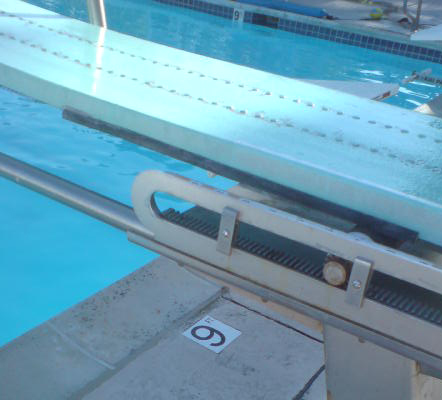
This is from a page of more potential diving board and slide rules.
___________________________________________
Good swimmers are likely to think they don’t need a lifeguard.
Some people are even offended at having to follow supposed safety rules. If they have done dangerous things before and not been hurt they are likely to want to be able to continue the same fun things.
Studies tell us why someone would, for example, dive into a pool
with a sign that said No Diving:
1) The familiarity effect; people who have done a lot of diving with no harm are less likely to comply with warnings. If your personal experience is that it has been safe for you, you gauge your future risk as low. Swim team members are among those most likely to ignore a warning sign.
This can be affected as well by never having known anyone who was paralyzed by a diving accident. Younger people in general do not have as many life experiences that tell them that warning signs might be valid.
2) People who are aware of a hazard decide they can minimize risk by trying to be safe. A diver knows that the water is shallow, but decides to try to attempt a dive with a shallow trajectory. Unfortunately, you have little control over dive angle.
3) Everyone else is doing it. If some people are diving where they should not it is more likely that others will as well, even with signs warning them not to.
4) Your internal reasons.
Some people are risk takers and are willing to risk the consequences. Disability and even death can result from a poorly done dive, but these results do not seem as likely to some people as to others.
Some people don’t like to have their behavior limited by orders from the manufacturer of a product or the manager of a pool.
__________________________________
Diving boards seem to invite more risky behavior and have even been shut down at some pools.
These rules are common for diving boards and must be followed in De Anza aquatics classes:
- Only one bounce allowed on the diving board.
-
- Only one person on the diving board at a time. This means people should wait at the bottom of the ladder until the person
- jumping or diving has done so, and should not approach the end of the board until the swimmer is clear.
- Don’t run on the board or attempt to dive a long way through the air.
- Swim away from the board immediately after diving so you aren’t a hazard for the next diver and so you are safe if the next diver doesn’t make certain the water is clear.
- Jump or dive only from the end of the board. Don’t use the guardrails for gymnastics. Trick dives only with permission.
Do not mix alcohol with swimming, diving or boating. Alcohol impairs your judgment, balance, and coordination, affects your swimming and diving skills, and reduces your body’s ability to stay warm.
A Canadian survey of drownings over a decade found that for people “15 years and older, alcohol was associated with 40% of drownings, however, since the presence of alcohol was unknown for another 25%, the true figure could be as high as 65%. Nearly 60% of the blood alcohol levels above the legal driving limit of 80 mg% were higher than 200 mg%; 18% were above 300 mg%.”
Water depth must be at least 9 feet when learning head-first entries from the deck (or deeper if state or local regulations require).
You should be physically and psychologically ready to do the skill. As you go along through the steps of learning to dive, if you find yourself unable to do a next step you should practice the preceding step until you gain confidence.
You should be able to demonstrate correct hand, arm and head position before trying to do a head-first entry. One way to do this would be to hold the arms over the head and in line with the body on a forceful push and glide from the pool side under water.
NEVER perform a head-first entry
Over stationary objects
Over any hard device, such as a pole
Through inner tubes or hoops
___________________________________
Know how to prevent, recognize, and respond to emergencies.
- · CHECK the victim
· CALL 9-1-1 or your local emergency number, and
· CARE for the person until help arrives
If you needed to get an ambulance to the De Anza pool, it would get there faster if you could describe to the 911 operator how to find the entrance to the pool complex. This could work: “take the Stelling road entrance into the college. The pool complex entrance is at the west end of the three story parking garage.”
Shivering is your body’s attempt to warm you up when you have gotten too cold. Don’t ignore shivering, it is a symptom of hypothermia, a general body cooling that develops when your body can’t generate enough heat to maintain normal body temperature. Air or water temperature does not have to be that cold to cause hypothermia. Recognize the symptoms of serious hypothermia: confusion, dizziness, exhaustion, a glassy stare, apathy and decreased levels of consciousness and/or severe shivering. Seek medical attention immediately if you have these symptoms. Hypothermia is the number one killer of people in the out-of-doors.
Out in the heat
·Drink plenty of water regularly and often even if you do not feel thirsty. Your body needs water to keep cool. Avoid drinks with alcohol or caffeine in them. They can make you feel good briefly but make the heat’s effects on your body worse. This is especially true with beer, which dehydrates you.
·Watch for signs of heat stroke: Heat stroke is life-threatening. The victim’s temperature control system, which produces sweating to cool the body, stops working. The body temperature can rise so high that brain damage and death may result if the body is not cooled quickly. Signals include hot, red, and dry skin; changes in consciousness, rapid, weak pulse, and rapid, shallow breathing. Call 9-1-1 or your local EMS number. Move the person to a cooler place. Quickly cool the body by wrapping wet sheets around the body and fan it. If you have ice packs or cold packs, place them on each of the victim’s wrists and ankles, in the armpits and on the neck to cool the large blood vessels. Watch for signals of breathing problems and make sure the airway is clear. Keep the person lying down.
·Wear eye protection: Good sunglasses are like sunscreen for your eyes and protect against damage that can occur from UV rays. Be sure to wear sunglasses with labels that indicate that they absorb at least 90 percent of UV sunlight.
Protect your skin: Sunlight contains two kinds of UV rays — UVA increases the risk of skin cancer, skin aging, and other skin diseases. UVB causes sunburn and can lead to skin cancer. Limit the amount of direct sunlight you receive between 10:00 a.m. and 4:00 p.m. and wear a waterproof sunscreen with a sun protection factor (SPF) containing a high rating such as 30, 45 or even 60. SPF 5 is a joke. Apply the sunscreen according to the directions; with many you can’t apply them and get in the pool right away or they will just wash off and make an oil slick in the pool.
At lakes and rivers: The only truly safe place to swim is with a lifeguard on duty but if you choose to swim without one:
· Select an area that has good water quality and safe natural conditions. Murky water, hidden underwater objects, unexpected drop-offs, and aquatic plant life are hazards. Water pollution can cause health problems for swimmers. Strong tides, big waves, and currents can turn an event that began as fun into a tragedy.
·Never swim alone.
·Make sure the water is deep enough before entering headfirst. Too many swimmers are seriously injured every year by entering headfirst into water that is too shallow. A feet first entry is much safer than diving.
·Avoid drainage ditches and arroyos. Drainage ditches and arroyos for water run-off are not good places for swimming or playing in the water. After heavy rains, they can quickly change into raging rivers that can easily take a human life. Even the strongest swimmers are no match for the power of the water. Fast water and debris in the current make ditches and arroyos very dangerous.
Your abilities as a surfer do not translate to ability in a strong river current.
See also: swimming in Yosemite National Park
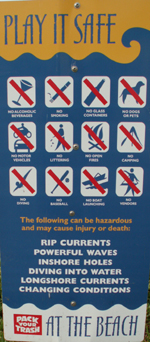
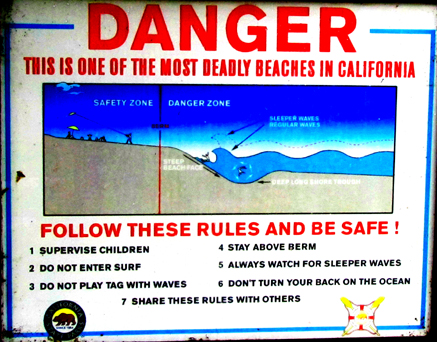
At the ocean:
Don’t turn your back on the ocean , big waves can sneak up on you. Read more at: rogue or sneaker waves, which also has rip current safety links.
Wear foot protection: People’s and dog’s feet get burned from the sand or cut from glass in the sand or burnt from coals of a beach campfire that was not put out completely.
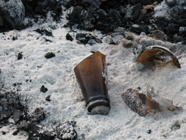 (Please note it is important to put out beach campfires thoroughly with water. If you bury them in wet sand you can also leave unseen hot coals.)
(Please note it is important to put out beach campfires thoroughly with water. If you bury them in wet sand you can also leave unseen hot coals.)
Stay within the designated swimming area, ideally within the visibility of a lifeguard.
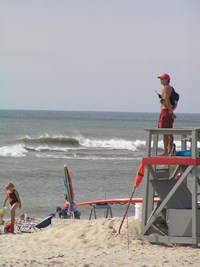
Never swim alone.
·Check the surf conditions before you enter the water. Check to see if a warning flag is up or check with a lifeguard for water conditions, beach conditions, or any potential hazards.
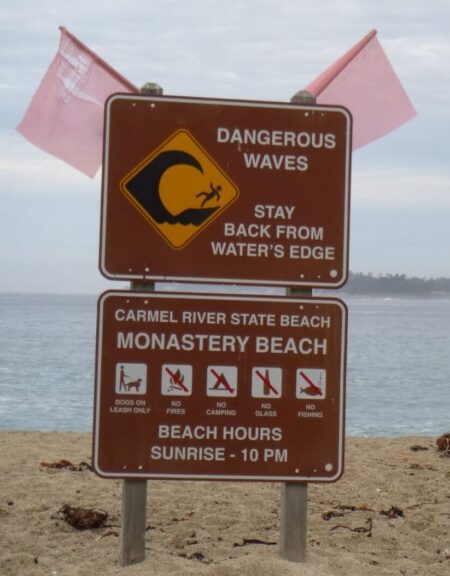
·Stay away from piers, pilings, and diving platforms when in the water.
·Keep a lookout for aquatic life. Water plants and animals may be dangerous. Avoid patches of plants. Leave animals alone.
·Make sure you always have enough energy to swim back to shore.
·Don’t try to swim against a current if caught in one. Swim gradually out of the current, by swimming across it.
Beach sand can be full of E.coli bacteria. Wash your hands after digging in the sand and making sand castles.
The CDC has a before you go to the beach brochure: http://www.cdc.gov/healthywater/pdf/swimming/resources/epa-before-you-go-to-beach-brochure.pdf
Surfrider Foundation State of the Beach report:
https://ee5-files.s3-us-west-2.amazonaws.com/publications/SOTB_2021.pdf
______________________________________
From the Canadian Red Cross:
“Holding your breath under water:
Think again! Canadian Red Cross strongly discourages Canadians from trying to hold their breath under water for extended periods of time. How long you can safely hold your breath depends on a number of factors including age, body mass and overall health. Most people can hold their breath comfortably for about 1-2 minutes. Trying to hold your breath for much longer than this, especially under water, may be dangerous. Our bodies need both oxygen (O2) and carbon dioxide (CO2) to survive. The impulse to breathe is triggered by a balance of O2 and CO2 in our blood stream. Many people will take several large, forced breaths or a series of short, fast breaths before trying to hold their breath under water for a long period of time. This is called hyperventilating, and it can disrupt the balance of O2 and CO2 in your body, fooling your brain into thinking that it doesn’t need to take another breath. If this happens, your body can quickly use up most of its available oxygen, and you can easily pass out. After you have passed out, the body’s natural responses will take over: you will gasp for breath, or you may stop breathing all together. Either way, if this occurs underwater, you are at serious risk for drowning.”
___________________________________
If you find yourself unexpectedly in the water while out boating:
Get on top of an over-turned boat or any wreckage !
Heart failure is the usual cause of death when the core temperature cools to below 30 degrees. The body loses heat to the water about 30 times faster.
No boat to climb up on? Self rescue wearing a lifejacket:
To conserve body heat while awaiting rescue in cold water, use the HELP position – the heat escape lessening posture. When two or more people wearing life jackets find themselves in cold water, the huddle position will help them conserve body heat while awaiting rescue.
(Fremont Union High School District coaches Kiernan Raffo, J C Hovland, Jill Borges and Jeremy Kitchen posed for these photos.)
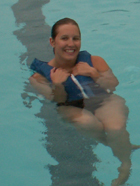 HELP Position
HELP Position
- 1.Draw your knees up to your chest.
2.Keep your face forward and out of the water.
3.Hold your upper arms at your sides, and hold your lower arms against or across your chest.
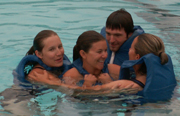 Huddle Position
Huddle Position
-
- 1. With two people, put your arms around each other so that your
- chests are together.
2. With three or more people, put your arms over each other’s shoulders so that the sides of your chests are together.
Children or elderly persons should be placed in the middle of the huddle.
____________________________________
The Red Cross book Small Craft Safety has these notes about what to do if you fall into moving water from a raft, canoe, etc. :
“Capsizes, falls overboard and collisions are common paddling accidents in moving water. If your boat capsizes or you fall overboard into moving water-
1) float downstream on your back with your feet in front of you. This will help you fend off rocks and avoid trapping your feet.
(Yosemite national Park also says: If you fall in, use the defensive position: on your back, feet pointing downstream and on the surface (can you see your toes?).)
2) Swim toward shore or into an eddy” … “(the sheltered area behind or downstream of an obstruction, where the currents flow upstream toward the obstruction)” …”as soon as it is safe to do so. If you are close to shore, if the water is cold, or if there are hazards further downstream, consider swimming toward shore.
–In shallow water, swim on your back at an angle against the current and toward shore.
–In deep water, swim on your front at an angle against the current and toward shore.
3) Do not stand up, you could catch your foot at an angle under a rock and become entrapped and pinned, even in just a few feet of water.
4) If necessary or practical, hold on to the craft for flotation
–hold on to a grab loop” (or other rope built into the raft), “keeping the craft in front of you.
–stay on the upstream end of the craft to avoid being caught between the craft and a rock.
–try to swim with the craft toward shore or into an eddy as soon as possible
–if necessary, let go of the craft and swim for shore.”
______________________________
Teton County (Wyoming) Search and Rescue would like you to know:
“Do not stand in moving water, even if shallow. If your foot gets trapped in the rocks, the current will push you over, wedging your foot tighter, and pushing your head underwater. You will drown. Others have drowned in 2 feet of water this way.”
Stay on the trail, away from fast moving water, even to just get your feet wet on a hot day
______________________________
The CDC has a drowning prevention brochure:
https://www.cdc.gov/drowning/prevention/index.html
The Grand Teton National Park boating brochure, with safety advice that applies many places, is at:
https://www.nps.gov/grte/planyourvisit/upload/boating19-access.pdf
see also Grand Teton trip kayaking.
______________________________
FAQ: One of the pools I swim at allows little kids with swim diapers. Do swim diapers or swim pants prevent fecal matter from entering the water?
According to the the Centers for Disease Control website the answer is “even though they may hold in some feces, they are not leak proof and can still contaminate the pool water.” For more go to
http://www.cdc.gov/healthyswimming/q_and_a.htm
and click on swim diapers and swim pants (and you can also find: E coli; diarrhea and pools; head lice, pinworm and swimming)
___________________________________
Two-thirds of drowning victims are good swimmers. Why you should wear a lifejacket.
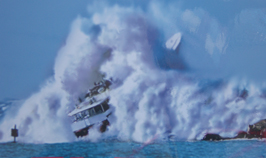
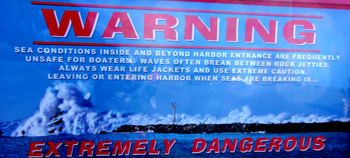
___________________________________
optional reading
You might find things you did not know at:
Should you use aloe cream on burns,
clean wounds with hydrogen peroxide to prevent infection,
use Crazy Glue to seal up a wound and prevent bleeding,
use tweezers to remove bee stingers or jellyfish tentacles?
NO, no, no, and no.
The above reading is a homework assignment in HLTH-057A,
the De Anza class for certification in Red Cross first aid (or just to learn first aid),
which meets your choice of Fall, Winter or Spring quarter, for
ONLY FOUR Friday afternoons.
Various swim students have taken the class in anticipation of possibly becoming lifeguards. One swim student got the highest A+ in the HLTH57A class fall quarter 2018, another swim student got a perfect score on the final exam in spring 2019. In Spring 2022, two swim students got A+ grades in the class, and one of them, who had practiced various lifeguard swim tests during swim class, went on to pass a lifeguard class two weeks later.
——————————————————————-
The author of this webpage, (written as a reading assignment for my students), does not give any warranty, expressed or implied, nor assume any legal liability or responsibility for the accuracy, completeness, or usefulness of any information, product, or process included in this website or at websites linked to or from it. Users of information from this website assume all liability arising from such use.

